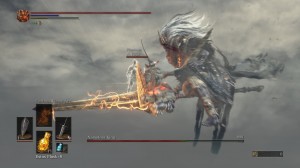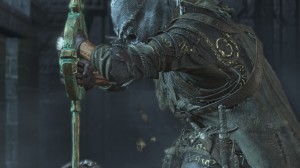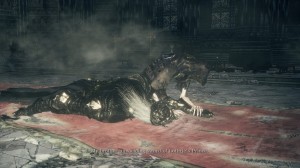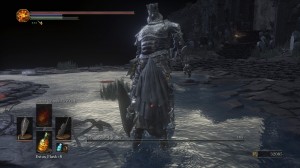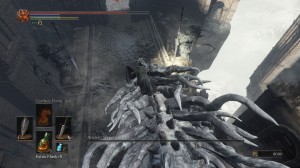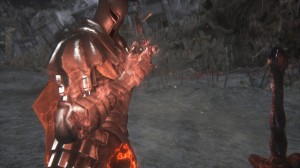Now that Dark Souls 3 has been out for awhile, it’s time to focus on the gameplay and actual mechanics of Dark Souls 3 beyond just reviewing the game. With each game, From Software makes a lot of subtle changes to the underlining combat systems and overall mechanics; some good, some bad and some up for debate.
(Warning: This post will be free to discuss spoilers of Dark Souls 3; read on at your own risk.)
Soulful:
If you missed my Dark Souls 3 review, you can find it here. While the overall mechanics and game structure hasn’t changed between the games, expert fans always notice the little things that are different with each Souls game.
Dark Souls 3 grows on Dark Souls 2’s expansion of the combat system, and features some touches from Bloodborne. While Dark Souls 2 may not be held as favorable as the original, it did improve on the combat with upgrades to dual wielding, weapon strike variety and just the overall feel of it.
The main problem with Dark Souls 2’s combat in my opinion was the adaptation stat. Adaptation worked by increasing the number of frames that a character was invincible during a roll. A low stat meant that the player only had a small window during the roll to avoid damage; larger one extended that.
The problem with this stat was that it became a false choice for players who wanted to go full melee. The more frames of invincibility you had, the greater the chance to avoid attacks and be able to follow through with a counterattack.
When you had bosses and large enemies who could easily kill you in a few hits, adaptation became that much more important. I reached a point with enough adaptation that I was just dodging effortlessly around bosses.
Dark Souls 3 has removed the stat and now everyone has a standard number of invincible frames, but the developers came up with a cleverer and more devious solution to making the game challenging.
Combo Crunch:
Previous Dark Souls games used a fairly similar AI behavior that made circle strafing and simple dodge rolls all you needed for the majority of the fights. With Dark Souls 3, the developers have enhanced the AI and made things a lot more dangerous.
Enemies routinely attack with not just multiple combos, but multiple variations on their combo strings. They have also been given the means to counter the specific tactics that worked in previous Souls games: Circle Strafing and knocking enemies out of their attack animation. I noticed many enemies were attacking me from the side or attempting to grab while strafing, and larger enemies have a lot of poise now; meaning, that it’s very hard to stun them out of combos.
But the real killer has to be the combos and what it means for dodging attacks. In previous games, enemies had at most two to three hits per combo string, so the player would dodge one hit and then the enemy would attack while the player was still moving away from the second one. Now, the player dodges one hit, enemy starts second attack while the player is still dodging, and then can connect with hits three, four and possibly five (six and seven if we’re talking about some bosses.)
This also goes with the redefined weight ratio for character builds. Weight ratio is a measurement of how much a character can hold vs. the weight of all their gear. The lower the weight ratio, the quicker and more responsive the character is; meaning that the character can roll faster, jump farther and feels a little more responsive during combat. If you try doing a dodge roll-focused build with a high weight ratio, expect many enemies to connect with their combos as you come out of the slower roll.
Faster characters can perform more dodge rolls in the same span compared to slower characters, so they can quickly dodge when the enemy starts doing hits three, four and five. This becomes even more apparent during the bosses, who again, have longer combo chains. This change in strategy also had the impact of reducing the effectiveness of blocking.
The reason is that stamina (which governs how much you can block) only recharges when your shield is down; when you have characters performing multi hit combos, they will quickly get through your endurance and leave you open for an attack.
I’m not a fan of this change, as it explicitly punishes players who don’t know to go all-in either with dodging or shield use. The problem is that if you’re not dodging fast enough, then you’ll still be hit by the middle part of the combo chain coming out of the dodge and then stun locked through it. There were many, many times where after being hit by an attack, my character would not move or dodge; leaving them to be hit again and again until they were killed.
If your shield and stamina aren’t up to par, then you won’t be able to absorb the entire combo and will either be left weaken after the attack, or the enemy will break through and still connect. Even then, you’ll find that no matter what quality shield you have, it’s very easy for enemies to break through your guard and leave you vulnerable to attack.
Increasing the difficulty and the frustration is the unhelpful camera. Due to how zoomed in it is during a fight, you will dodge the enemy’s attack to only lose them off screen, just in time for them to come back on while attacking you with the remaining moves in their string. And of course, don’t get me started on how the camera works when fighting large enemies like the giants or Wolnir, or fast moving enemies like the Abyss Watchers or Pontiff.
Next, let’s talk about gear and the actual ways of doing damage.
Dressed up:
Dark Souls 3 features a wide assortment of weapons, including the weapon class specific skills taken from Bloodborne. The weapon variety is one of the best in the series and the new weapon skill system provides an additional pro for dual wielding. Although I do miss the dual-wielding exclusive attacks you had access to, compared to only having those moves on dual wielding specific weapons this time around.
One debatable choice that I’m sure fans are going to argue about is the removal of upgrading gear pieces with shards. Previously, you could upgrade armor as you would weapons; giving them higher stats and providing another use for those resources. Personally, I’m not a fan of removing this feature, as it provided another means of progression and gave players an alternate option for upgrading if they get stuck at a section.
As for the actual combat, Dark Souls 3 still exists as a middle ground between the choices in an action game and the abstraction seen in RPGs. I’m split between the idea of the developers expanding the combat with more actual moves or in-game combos.
On one hand, the combat system is fairly basic, but on the other it’s still button-heavy thanks to using all four of the shoulder buttons.
I think my main problem with Dark Souls 3’s combat is that it doesn’t entirely evolve the player’s options in step with the changes to enemies. I would have liked more expert means of mitigating damage and even trying to counter enemies while in mid-combo string.
The parry/riposte system is still present, but there are a lot of large enemies and humanoid bosses where you can’t use them against their attacks; leaving the player with the only options of block or dodge.
One last thought for this section. Given the speed and variety of attacks on enemies, it has become very difficult to actually spot safe points during combat. I’ve seen enemies strike in such a way that it appears like their attack will hit you from behind them, and of course the leaving and entering of the screen mentioned before. Many enemies seem to flail around with their attacks, especially later enemies and bosses; further making it difficult to know when it’s safe to attack. The game also has the same bug/feature of enemies allowed to attack through each other, further making things difficult.
With that said, there’s still a lot to talk about it, and we’ll wrap up focusing on combat with talking about enemy and boss design.
A Rock and a Hard Place:
From the last section, the enemies have been given major improvements all around in terms of their AI and possible moves to use. This in turn makes Dark Souls 3 also have some of the most varied enemy and boss designs of the series. From fighting zombies, monsters made out of leeches, infected hollows and more, there are a lot of enemies here to kill you.
Despite having so much variety, the developers have done a great job of differentiating the different enemies, even those of the same species from each other. I know when I see a skeleton with a blue robe that that’s different from a skeleton with a giant two-handed sword.
The boss designs are also some of the most varied in the series and goes back to Dark Souls 1 and Demon’s Souls in terms of design. Some bosses are built around a specific quirk that you must figure out; such as the Deacons of the Deep, Crystal Sage or Wolnir. Other bosses are designed as straight up combat scenarios where you must get around their combos and fight them in combat, such as the Abyss Watchers, Old Demon King or the Pontiff fight.
To briefly talk about, my favorite bosses of Dark Souls 3 would be the pontiff fight, nameless king, Wolnir, the final fight, the twin princes and the deacons of the deep.
Due to the change in combo structure and play style, the bosses also require a lot more care when fighting them; getting close and mashing attack will most likely get you killed. As before, if fights are too difficult, you have the option to ember up and summon phantoms to aid you; which makes a lot of the fights very easy. I wish that the bosses and enemies weren’t able to string their combos so effectively though, as there were plenty of cases of the boss finishing a 3+ hit combo, to then go immediately into its next combo before I had a chance to hit it.
I do like how the enemies are a lot more dynamic this time around; fighting some of the later enemies and black knights, they pulled out different strategies in their routines.
However, it seems like it’s a lot harder to break their attacks this time around; with larger enemies recovering after two or three hits. Instead of making combat more interesting, it simply reduces it down to the same strategy of: Figure out how to get one hit in and get away from the combo chain and repeat until dead.
The problem is how the poise system has changed and what it means for fighting enemies. Previously, poise allowed you to attack through taking damage from someone else depending on the weapon used. It has been determined by the player base and examining the code, that the poise system has been disabled for both PvE and PvP at this moment in time.
What that means is that the system to allow players to attack through being hit is gone; reducing the utility of heavier armor. This also impacts the weapon system and makes slower weapons completely useless in most fights. The reason is that either A, you won’t be able to hit the fast moving enemy, or B, the boss will already start its next combo chain before you have time to finish your strike and get out of the way.
I would have even been find with letting one hit stun an enemy, but then give them a chance or just allow them to perform a counterattack if the player doesn’t back off; just like the evangelist enemies in the Undead Settlement. It’s not tactical when I’m fighting a black knight and just repeat the same thing of dodge, hit, dodge again and repeat. There was one point where I was fighting a larger knight in the corrupted garden and he did not stop attacking, and there was no way to knock him out of his attacks either.
This removes a lot of the choice behind building characters and does something far worse to the game’s design: It presents a situation where the player is not on even footing with combat against enemies. The player can be knocked out of their attacks and simply stunned to death, while the enemies don’t have that same problem. That presents an inconsistent design and makes the game cheap in regards to combat.
The developers have “hyper armor” in the game, where attacks from heavy weapons like ultra great swords will prevent the player from being knocked out of the swing, unless they are hit by a lot of attacks or one strong one. It’s a good idea in principle, but it’s still not a reliable replacement from poise and makes it very awkward when ultra weapon wielding characters fight.
The later bosses such as champion Gundyr and Oceiros feature moves and combos where they are just literally attacking nonstop within their combos and afterwards; making it all but impossible to get more than a single strike in. Is this difficult? Yes, but it’s not asking the player to grow or improve their skills when the bosses are just attacking like they’re hopped up on energy drinks.
The problems with the boss mechanics can be proven by how these bosses and their designs break if you have one other person joining you for the fight. The reason is that while the boss is focusing down one person with their crazy combos, the other simply needs to follow behind and attack their back and then reverse it when the boss changes priority.
To wrap up this section, in my opinion, without having poise active breaks PvP in my opinion. The reason is that it makes combat about who has the faster attack, because they can stop the opponent from attacking and stunlock them to death.
There is no reason why a little sword should stop me from swinging a massive two handed hammer. The only attacks from what I’ve seen that aren’t stopped are weapon arts and the non specified hyper armor-based attacks, but it once again means that you are limited to a few options in order to be effective.
For our final section before wrapping up, let’s talk world design.
Seeing the Sights:
Dark Souls 3 from a level design standpoint is one of the best of the series and easily beats Dark Souls 2. Each area is full of secrets and a variety of obstacles and designs. Enemies rarely appear again in new areas and the lore surrounding them and the environments continues to be mysterious and deep.
With that said, there are a few complaints I have with the design. The amount of secret areas and walls that are placed in innocuous areas is extreme, and there were plenty of important items and things that I would have never found in a million years without a message cluing me in. This is a game where missing one corridor could mean missing out on an entirely new area, quest and/or important item. There were some things that without a message or looking it up, I would literally have never found it, because of how obscure they were.
And yet with that said, I know I missed a ton of stuff; I’m willing to bet a lot of game changing options that would have made life a lot easier if I discovered them. On my second playthrough, I realized that I completely missed the sorcery vendor in the first swamp area, along with the Sun Covenant location.
As with previous games, expect to find doors and quests that you will have no idea how to progress without the aid of a guide or video. Thankfully, Dark Souls 3 continues the trend of letting you teleport to all unlocked bonfires from the start, or the frustration level would be too high.
While the individual levels are some of the series’ best, the world geography is a bit lacking compared to previous games.
You’ll find that the actual path through the game is quite linear; with areas only linked in terms of forward momentum. This is different from Dark Souls and how areas connected to each other and allowed for more multiple entries and general connective-ness.
Dark Souls 3 feels like the greatest hits of Dark Souls 1 and Demon’s Souls; with poison swamp areas, the return to Anor Londo and more. The level design continues to do a great job of making you both work for shortcuts and bonfires, and then being very gratified when you get there.
As for the lore, again, I’m not the lore guy and I’m going to leave that to someone more versed in it talk about.
Try to Set the Night on Fire:
Rating Dark Souls 3 is definitely a tough one. Compared to Dark Souls 2, 3 is hands down better in every regard. As for number one, that’s tricky. I feel that the developers are outpacing the design and mechanics set up with making enemies more dangerous and difficult to fight, while not fixing the problems and issues on the player’s side of things.
Dark Souls 1 in my opinion felt like everything worked in harmony more. The difficulty of fighting enemies, poise disabled and the camera problems takes Dark Souls 3 to the “cheap” side of difficulty. When you have fights and design decisions that explicitly are designed against the design of the game and options for the player, that creates some cheap situations.
At the moment, Dark Souls 3 is on the easy side in some sense, not because the game rewards players for learning mechanics or systems, but because a lot of the choices and options have been downplayed because of the underlining changes. Once you learn that fast weapons are superior because there is no poise, it becomes so much easier to get through the game.
The positive is that the problems are more on the numbers and underlining mechanics side of things; things that could be fixed with a few general tweaking on the back-end.
This isn’t like Dark Souls 2 where the problems were with the actual systems and designs; something that can’t be fixed with patches.
With DLC along the way and more patches, it’s important to remember that the things talked about here may not be relevant in a year or even a few months from now.
With everything said, Dark Souls 3 is definitely a return to form for the series after #2; where it goes from here is anybody’s guess. If you can put up with the difficulty curve and design decisions, you’re going to find another amazing game, but for me, it’s too much frustration and not enough reward at the moment to make me want to keep touring Lorthic a second or third time around; much less hang around for invades.
For video content on Dark Souls 3, you can check out my completed playlist, including fighting the final boss fight.
If you enjoyed this post, please consider donating to the Game-Wisdom Patreon campaign. Your donations will help keep the site running and let me continue to put out great content.



